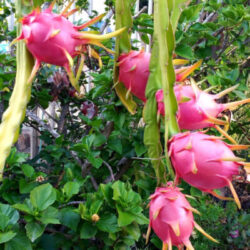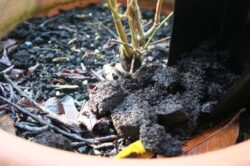
Fruit trees are popular among gardeners because of their delectable fruit, but they are also popular with squirrels since they frequently climb trees to eat the sweet fruit.
For gardeners who are eager to reap a plentiful crop, this might be upsetting. Fortunately, there are a number of practical methods to deter squirrels from accessing your fruit tree. This essay will examine those techniques and offer advice on how to keep these bothersome rodents away from your fruit tree.
Understanding the squirrel problem
Squirrels are excellent climbers and have acute senses of taste and smell. The aroma of ripe fruit draws them to fruit trees, and they will scale trees to get to the fruit. Squirrels are very tenacious and will keep climbing trees until they succeed in reaching the fruit.
Why squirrels are attracted to fruit trees
Squirrels are attracted to fruit trees because they provide a readily available food source. Fruit trees produce fruits and nuts that are high in nutrients and energy, making them an ideal food source for squirrels. Additionally, squirrels are opportunistic feeders, and fruit trees provide a relatively easy and accessible source of food. Squirrels are also attracted to fruit trees for shelter and nesting opportunities. Fruit trees provide a safe and protected environment for squirrels to build their nests and raise their young.
The damage squirrels can cause to fruit trees
Squirrels can cause significant damage to fruit trees, which can ultimately lead to reduced fruit production and even the death of the tree. Some common types of damage that squirrels can cause to fruit trees include:
- Eating the fruit: Squirrels will often eat the fruit right off of the tree, leaving behind only the core or seeds. This can significantly reduce the fruit yield and quality.
- Gnawing on the bark: Squirrels will often gnaw on the bark of fruit trees, causing damage to the tree’s cambium layer. This can interfere with the tree’s ability to transport nutrients and water, which can lead to reduced fruit production or even the death of the tree.
- Damaging branches: Squirrels will sometimes climb and jump on fruit tree branches, causing them to break or become damaged. This can also interfere with the tree’s ability to produce fruit.
- Nesting damage: Squirrels will sometimes build their nests in fruit trees, which can cause damage to the tree’s structure and interfere with fruit production.
Overall, squirrels can cause significant damage to fruit trees, and it’s important to take steps to deter them in order to protect the health and productivity of the trees.
Also Read: how to Make Trellis for BlackBerries
Understanding squirrel behavior and habits
Understanding squirrel behavior and habits can be helpful in developing effective strategies to deter them from fruit trees. Here are some important aspects to consider:
- Feeding habits: Squirrels are omnivores and will eat a wide variety of foods, including nuts, seeds, fruits, and insects. They are also opportunistic feeders and will take advantage of any available food source.
- Nesting behavior: Squirrels build nests, or dreys, in trees or other high places. They will typically use a variety of materials, including twigs, leaves, and grass.
- Activity patterns: Squirrels are diurnal, meaning they are active during the day. They are also highly territorial and will defend their territory against other squirrels.
- Mobility: Squirrels are agile climbers and can easily navigate tree branches and other structures. They can also jump up to 8 feet horizontally and 4 feet vertically.
- Reproduction: Squirrels typically mate twice a year, in early spring and late summer. They have litters of 2-8 offspring, which they care for in their nests.
Understanding these habits and behaviors can help in developing effective strategies for deterring squirrels from fruit trees. For example, using physical barriers or repellents that exploit their agility and territorial instincts can be effective.
Also Read: Are kiwi Fruits Acidic or Alkaline
The importance of addressing the squirrel problem
Addressing the squirrel problem is important for several reasons:
- Protecting fruit trees: Squirrels can cause significant damage to fruit trees, which can ultimately lead to reduced fruit production or even the death of the tree. Taking steps to deter squirrels can help protect the health and productivity of fruit trees.
- Reducing property damage: Squirrels can also cause damage to other structures, such as roofs and attics, by gnawing on wood and wires. This can lead to costly repairs and potential safety hazards.
- Preventing safety hazards: Squirrels can also pose safety hazards by chewing on electrical wires and creating fire hazards. They can also carry diseases and parasites that can be harmful to humans and pets.
- Promoting ecosystem balance: While squirrels are an important part of the ecosystem, an overabundance of squirrels can disrupt the balance of other wildlife populations. Addressing the squirrel problem can help promote a healthier and more balanced ecosystem.
Overall, addressing the squirrel problem is important for protecting property, promoting safety, and maintaining a healthy ecosystem. By taking steps to deter squirrels, property owners can help ensure the long-term health and productivity of their fruit trees and other structures, while also promoting a safe and balanced environment for all.
Identifying vulnerable fruit trees
Some types of fruit trees are more vulnerable to squirrel damage than others.
Types of fruit trees that are most susceptible to squirrel damage
Squirrels can damage a wide variety of fruit trees, but some types are more susceptible than others. Here are some fruit trees that are particularly vulnerable to squirrel damage:
- Apple trees: Squirrels are known to be particularly fond of apples, and apple trees are often a favorite target for squirrel feeding and nesting.
- Peach trees: Peach trees produce sweet, juicy fruits that are attractive to squirrels, and the trees’ thin bark makes them vulnerable to squirrel damage.
- Cherry trees: Cherry trees produce small, sweet fruits that are also attractive to squirrels, and the trees’ horizontal branches make them easy for squirrels to climb.
- Walnut trees: Squirrels are known to love walnuts, and walnut trees produce large nuts that are a favorite squirrel food.
- Pecan trees: Pecans are another favorite food of squirrels, and pecan trees are often a target for squirrel feeding and nesting.
While these fruit trees are more susceptible to squirrel damage, it’s important to note that squirrels can damage a wide variety of fruit trees. Taking steps to deter squirrels, such as using physical barriers or natural deterrents, can help protect all types of fruit trees from squirrel damage.
Signs of squirrel activity in fruit trees
Here are some signs of squirrel activity in fruit trees:
- Missing or damaged fruit: Squirrels may climb the tree to eat the fruit directly from the branches or may knock the fruit to the ground while trying to access it.
- Chewed bark and branches: Squirrels may chew on the bark and branches of fruit trees, particularly in areas where they are building a nest or accessing food.
- Squirrel nests: Squirrels build nests, or dreys, in trees or other high places. These nests can be a sign of squirrel activity in the fruit tree.
- Scattered debris: Squirrels may leave debris around the base of the tree, such as nutshells, leaves, and twigs, as they feed or build their nests.
- Claw marks on the bark: Squirrels have sharp claws that can leave marks on the bark of the tree as they climb or descend.
- Chattering and scampering sounds: Squirrels are vocal animals and may make chattering or scampering sounds as they move through the tree or nearby branches.
If you notice any of these signs of squirrel activity in your fruit tree, it’s important to take steps to deter the squirrels and protect your tree from further damage.
Factors that make fruit trees more vulnerable to squirrels
Here are some factors that can make fruit trees more vulnerable to squirrels:
- Tree location: Fruit trees that are located near wooded areas, where squirrels are abundant, are more vulnerable to squirrel damage.
- Tree size and shape: Trees with thin bark or low branches that are close to the ground are more accessible to squirrels, making them more vulnerable to damage. Similarly, trees with a bushy or dense canopy can provide squirrels with more cover and make it easier for them to move around undetected.
- Fruit ripeness: Squirrels are attracted to ripe fruit, so trees that have ripe or nearly ripe fruit are more vulnerable to squirrel damage.
- Time of year: Squirrels are most active during the fall when they are gathering food for the winter. Fruit trees that have ripe fruit during this time are particularly vulnerable.
- Lack of deterrents: Fruit trees that are not protected by physical barriers or natural deterrents are more vulnerable to squirrel damage.
By understanding these factors, property owners can take steps to protect their fruit trees from squirrel damage. For example, planting fruit trees away from wooded areas, pruning lower branches, and using physical barriers or natural deterrents can all help make fruit trees less vulnerable to squirrel damage.
Also Read: Is coconut Water Acidic? All you need to know
Assessing the level of squirrel damage to fruit trees
Assessing the level of squirrel damage to fruit trees can help property owners determine the best course of action to protect their trees. Here are some ways to assess the level of squirrel damage:
- Check the fruit: Look for signs of damage to the fruit, such as bite marks, missing chunks, or hollowed-out areas. If a significant amount of fruit is missing or damaged, this could indicate a high level of squirrel activity.
- Check the tree: Examine the tree for signs of damage to the bark or branches. If you see chew marks, claw marks, or broken branches, this could indicate that squirrels are accessing the tree.
- Look for nests: Check for squirrel nests in nearby trees or other high places. If you see several nests in the area, this could indicate a high population of squirrels.
- Monitor activity: Observe the tree and the surrounding area for signs of squirrel activity. If you see squirrels moving through the tree or feeding on the fruit, this indicates a high level of activity.
By assessing the level of squirrel damage, property owners can determine the severity of the problem and choose the most effective methods for protecting their fruit trees. If the damage is minimal, natural deterrents or physical barriers may be enough to prevent further damage. However, if the damage is significant or the squirrel population is high, more intensive measures, such as trapping and relocation, may be necessary.
How To Keep Squirrels Out Of Fruit Trees
1. Natural deterrents for keeping squirrels away
There are several natural deterrents that can be used to keep squirrels away from fruit trees and other areas where they can cause damage. Here are some examples:
Using spicy repellents to deter squirrels
Using spicy repellents can be an effective way to deter squirrels from fruit trees. Here are some tips for using spicy repellents:
- Choose the right repellent: There are many types of spicy repellents available, including sprays, powders, and liquids. Look for a repellent that is safe for use on fruit trees and has proven effective against squirrels.
- Apply the repellent correctly: Follow the manufacturer’s instructions for applying the repellent to the tree and fruit. In general, you’ll want to apply the repellent directly to the fruit, as well as any areas where squirrels are accessing the tree.
- Reapply regularly: Spicy repellents can wear off over time, especially if it rains or if the fruit is frequently touched or brushed against. Reapply the repellent regularly to ensure continued protection.
- Use caution when handling the repellent: Spicy repellents can irritate the skin, eyes, and respiratory system. Wear gloves and a mask when applying the repellent, and avoid getting it on your skin or in your eyes.
While spicy repellents can be effective at deterring squirrels, they may not be a good choice for everyone. Some people find the smell or taste of the repellent unpleasant, and it may not be suitable for use on all types of fruit trees. Be sure to read the label carefully and follow all safety instructions when using any type of repellent.
Planting herbs and other plants that repel squirrels
Planting herbs and other plants that repel squirrels can be a natural and effective way to deter them from fruit trees. Here are some plants that are known to repel squirrels:
- Mint: Squirrels dislike the strong scent of mint, so planting it around the base of the fruit tree can help deter them.
- Garlic: Garlic has a strong odor that squirrels find unpleasant. Planting garlic bulbs around the base of the tree can help repel them.
- Daffodils: Squirrels dislike the scent of daffodils and may avoid areas where they are planted.
- Alliums: Alliums, such as onions and chives, have a strong odor that can help deter squirrels.
- Marigolds: Marigolds have a strong scent that many pests, including squirrels, find unpleasant. Planting them around the base of the fruit tree can help keep squirrels away.
- Fritillaries: Squirrels dislike the scent of fritillaries and may avoid areas where they are planted
Installing motion-activated sprinkler systems
Installing motion-activated sprinkler systems can be an effective way to deter squirrels from fruit trees. Here’s how it works:
- Install the sprinkler system: Choose a motion-activated sprinkler system that is designed for use in gardens and yards. Install the sprinkler system near the fruit tree, making sure that it is positioned to cover the area where squirrels are accessing the tree.
- Adjust the settings: Most motion-activated sprinkler systems have adjustable settings, such as the sensitivity of the motion sensor and the spray range. Adjust the settings to ensure that the sprinkler system will activate when squirrels approach the tree.
- Test the sprinkler system: Test the sprinkler system to make sure that it is working properly. Walk in front of the motion sensor to trigger the sprinkler and verify that it sprays water as expected.
- Monitor and maintain the sprinkler system: Check the sprinkler system regularly to make sure that it is still functioning properly. Replace batteries as needed and clean the sprinkler head to prevent clogs.
Motion-activated sprinkler systems work by detecting the movement of squirrels and spraying them with a burst of water. This can startle and deter the squirrels, making them less likely to return to the area. While motion-activated sprinkler systems can be effective, they do require some maintenance and monitoring to ensure that they continue to work properly.
Using predator urine as a natural squirrel repellent
Using predator urine as a natural squirrel repellent is a method that some people use to deter squirrels from fruit trees. Here’s how it works:
- Purchase predator urine: Predator urine is available for purchase online or at some garden centers. The urine is typically sourced from predators such as coyotes, foxes, and bobcats.
- Apply the urine around the base of the fruit tree: Pour the urine around the base of the fruit tree or apply it to cotton balls or other absorbent material and place them around the tree. This will create a scent barrier that may deter squirrels from approaching the tree.
- Reapply as needed: Predator urine will break down over time and lose its effectiveness. Reapply the urine as needed to maintain the scent barrier.
It’s important to note that while predator urine may be effective in some cases, it is not a guaranteed method for keeping squirrels away from fruit trees. Some squirrels may become accustomed to the scent over time and continue to approach the tree. Additionally, some people may find the scent of predator urine unpleasant, so it’s important to consider this before using it as a repellent.
Creating distractions for squirrels away from fruit trees
Creating distractions for squirrels away from fruit trees can be an effective way to keep them from damaging the fruit on the tree. Here are some ways to create distractions for squirrels:
- Install a squirrel feeder: Setting up a squirrel feeder in a location away from the fruit trees can help redirect the squirrels’ attention. Fill the feeder with nuts, seeds, or other treats that squirrels enjoy.
- Provide water: Squirrels need access to water, so providing a water source away from the fruit trees can help keep them occupied.
- Set up a squirrel obstacle course: Squirrels are naturally curious and enjoy exploring their surroundings. Setting up an obstacle course with ramps, tunnels, and other obstacles can provide a fun distraction for squirrels.
- Scatter food around the yard: Scattering nuts, seeds, and other food items around the yard can help create a scavenger hunt for squirrels
2. Physical barriers to prevent squirrel access
Using physical barriers to prevent squirrel access to fruit trees can be an effective way to protect the fruit. Here are some common types of physical barriers:
- Netting: Covering the fruit trees with netting is one of the most effective ways to keep squirrels away from the fruit. The netting should be made of a durable material and be tightly woven to prevent squirrels from getting through.
- Collars: A collar made of a slippery material, such as PVC piping or metal flashing, can be placed around the trunk of the fruit tree to prevent squirrels from climbing up the tree.
- Pruning: Pruning the branches of the fruit tree can help prevent squirrels from accessing the fruit. Trim the branches so they are at least six feet away from any structures or other trees that squirrels can climb up.
- Tree guards: Wrapping the trunk of the fruit tree with a metal or plastic guard can prevent squirrels from climbing up the tree.
- Electric fencing: Installing an electric fence around the perimeter of the fruit trees can provide a physical barrier that squirrels are unlikely to cross.
It’s important to note that physical barriers should be installed correctly and checked regularly to ensure they are still effective. Additionally, it’s important to choose a physical barrier that is appropriate for the size and type of fruit tree you have.
Also Read: is Acai Acidic Or alkaline? All You should know
3. Trapping and relocating squirrels
Trapping and relocating squirrels is a controversial method of controlling squirrel populations, and in some areas, it may be illegal. Before considering trapping and relocating squirrels, it’s important to research the laws in your area and consider the potential consequences.
Here are some steps to follow if you decide to trap and relocate squirrels:
- Choose a humane trap: There are different types of traps available, but it’s important to choose a trap that is humane and won’t harm the squirrel. Live traps, such as box traps or cage traps, are effective options.
- Bait the trap: To lure the squirrel into the trap, use bait such as nuts, seeds, or peanut butter.
- Check the trap frequently: Check the trap at least once a day to ensure that the squirrel is not trapped for an extended period of time. Trapped squirrels can become stressed, dehydrated, and hungry, which can be harmful to their health.
- Relocate the squirrel: Once the squirrel is trapped, it should be relocated to a suitable habitat at least five miles away from the original location. Relocation should only be done in areas where it’s legal and safe to do so.
It’s important to note that trapping and relocating squirrels may not be a long-term solution, as other squirrels may move into the area to take their place. Additionally, squirrels are important members of many ecosystems and play an important role in seed dispersal and pollination. If possible, it’s best to try alternative methods of controlling squirrel damage before resorting to trapping and relocating them.
4. Creating alternative feeding stations for squirrels
Creating alternative feeding stations for squirrels can be an effective way to keep them away from fruit trees and other areas where they can cause damage. Here are some steps to follow when creating alternative feeding stations:
- Choose a location: Select an area away from fruit trees and other areas where squirrels may cause damage. It’s important to choose an area that is easily accessible to squirrels.
- Provide food: Place food such as nuts, seeds, and fruits in a feeder or scatter it on the ground. Squirrels prefer sunflower seeds, peanuts, and corn.
- Use squirrel-proof feeders: Use squirrel-proof feeders that are designed to prevent squirrels from accessing the food. These feeders usually have metal cages around them that allow smaller animals such as birds to access the food, but prevent squirrels from entering.
- Offer water: Provide a water source, such as a bird bath, for the squirrels to drink from.
- Maintain the feeding station: Clean the feeding station regularly to prevent the spread of disease and to keep the area tidy.
Creating alternative feeding stations for squirrels can help redirect their attention away from fruit trees and other areas where they can cause damage. However, it’s important to note that this method may not completely eliminate squirrel damage, and some squirrels may continue to search for food in other areas.
5. Maintenance and monitoring for long-term success.
Maintaining and monitoring your squirrel control efforts is important for long-term success. Here are some tips for maintaining and monitoring your squirrel control methods:
- Regularly inspect fruit trees: Check fruit trees for signs of squirrel damage on a regular basis, especially during the growing season. Look for bite marks on the fruit, missing or broken branches, and signs of nesting.
- Check physical barriers: If you’ve installed physical barriers, such as netting or fences, check them regularly to ensure that they’re intact and properly secured. Repair any damage immediately.
- Monitor alternative feeding stations: If you’ve created alternative feeding stations for squirrels, monitor them regularly to ensure that they’re being used and that the food is not attracting other pests, such as rats.
- Maintain spicy repellents: If you’ve used spicy repellents, reapply them periodically, especially after rain or watering. Some spicy repellents may lose their effectiveness over time, so it’s important to monitor them closely.
- Remove fallen fruit: Fallen fruit on the ground can attract squirrels, so it’s important to remove it promptly. Rake up fallen fruit and dispose of it in a sealed container or compost bin.
By maintaining and monitoring your squirrel control efforts, you can ensure that they’re effective in the long term. If you notice an increase in squirrel activity or damage, you may need to adjust your methods or try new ones to achieve the best results.
Conclusion
In conclusion, keeping squirrels out of fruit trees can be a challenge, but there are several effective strategies for preventing squirrel damage. Identifying vulnerable fruit trees, using natural deterrents and physical barriers, creating alternative feeding stations, and regular maintenance and monitoring can all help to deter squirrels and protect your fruit trees. It’s important to take a long-term approach and to choose strategies that are humane and environmentally friendly. By taking proactive steps to prevent squirrel damage, you can enjoy a bountiful harvest of delicious fruit from your trees.
FAQs
Sure, here are some frequently asked questions about keeping squirrels out of fruit trees:
- Can I use traps to remove squirrels from my fruit trees?
Yes, you can use traps to remove squirrels from your fruit trees. However, it’s important to check local regulations and laws regarding trapping and relocation of wildlife. It’s also important to use humane traps and release the squirrels in a safe and appropriate location.
- What are some physical barriers I can use to keep squirrels out of my fruit trees?
Physical barriers such as tree guards, netting, and collars can be effective in keeping squirrels away from fruit trees. Tree guards are made of metal or plastic and can be placed around the trunk of the tree to prevent squirrels from climbing up. Netting can be draped over the tree to prevent squirrels from accessing the fruit. Collars can be placed around the base of the tree to prevent squirrels from digging under the soil to access the tree roots.
Can I use repellents to keep squirrels away from my fruit trees?
Yes, there are several natural repellents that can be effective in deterring squirrels, including predator urine, spicy sprays, and plants that squirrels find unappealing.
- How can I tell if squirrels are causing damage to my fruit trees?
Signs of squirrel damage include missing or partially eaten fruit, bark that has been stripped from the tree, and gnaw marks on branches and twigs. You may also notice squirrel nests in the branches of the tree.
- What are some long-term strategies for preventing squirrel damage to fruit trees?
Long-term strategies for preventing squirrel damage include regular monitoring and maintenance, using physical barriers and repellents, and creating alternative feeding stations for squirrels. It’s also important to choose fruit tree varieties that are less vulnerable to squirrel damage.







